Background Data
Fish are coldblooded animals with their body temperatures controlled by their environments. Temperature directly affects their activities, and each fish species has an ideal temperature range in which they are the most active. Since fish can detect changes as slight as 0.1° F, a small change in temperature does not go unnoticed.
Likewise, aquatic insects are cold blooded creatures. Temperature influences insects’ activities such as emergence and migration. Because aquatic insects are a fish’s primary food source, their availability directly influences the fish’s feeding activities. A water’s greatest thermal source is solar radiation which is directly absorbed. The surrounding air mass likewise affects water’s temperature by conduction at the surface. Heat is also transferred from the water’s bottom sediments and adjacent rocky shorelines. This last source has only a minor influence on water temperature; the first two factors play primary roles.
Water loses heat from evaporation, outlet flows, and air conduction. Wind action distributes heat in a body of water by causing waves which mix the water.
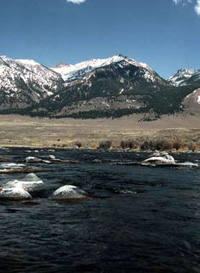
A large water mass is slow to change temperature as it is efficient at holding its energy. Consequently, large lakes are slow to warm up in the spring; likewise, they are slow to cool down in the fall. It requires a tremendous amount of energy measured in kilocalories to influence a temperature change in a large body of water. This is why water temperatures always lag behind the air temperature changes.
Lakes stratify or divide into three layers defined by both temperature and oxygen content. The water’s oxygen content and temperature are inversely proportionate. That is the cooler the water the more oxygen it will hold; conversely, the warmer the water the less oxygen it will hold. In general, water is at its greatest weight density when it is at 39.2° F. As a result, the deepest water will be the densest and closest to this 39.2° F. As water warms it becomes proportionally less dense and stratifies towards the surface. Water cooler than 39.2° F also becomes less dense and will be found at the surface. Water’s melting/ freezing point is at about 32° F and this is found at the surface because it is less dense than the 39.2° F water. Ice is a solid phase which due to its crystalline structure is even less dense than its liquid phase. That is why ice develops on a lake’s surface.
During warm weather times, a lake stratifies into epilimnion, thermocline, and hypolimnion layers. (See Diagram 1)
The epilimnion is the uppermost layer which is both well oxygenated and uniform in temperature. The thermocline is a mid layer containing a drastic temperature reduction and decreased oxygen content. The hypolimnion is the bottom layer characterized by both the lowest oxygen content and the coldest water approaching 39.2° F. These bottom two layers are oxygen poor because they are remote from the oxygen producing surface and aquatic plant areas. These layer’s increased densities cause a barrier which seals them from obtaining additional oxygen supplies.
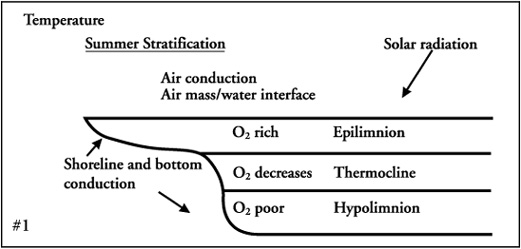
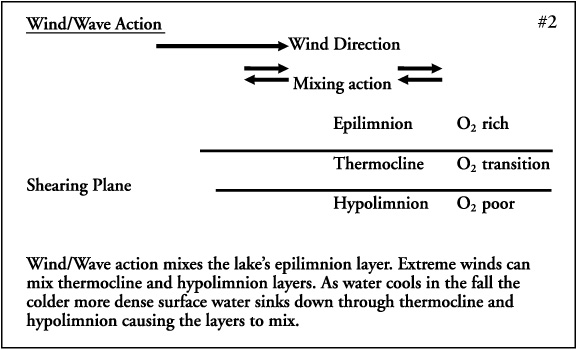
As a result, thermocline and hypolimnion layers are oxygen poor.
In the fall as water temperatures approach 32° F throughout, the lake mixes and these stratification layers are lost. (See figure 2) At this time all of the lake’s water reaches the same temperature and density. This blending distributes the oxygen evenly throughout the lake. Wind and wave action also help the mixing. After ice out in the spring, this wave action again mixes the water and causes the loss of winter thermal stratification. These periods are often referred to as spring and fall turnover times. Since the turnover mixes the oxygen evenly, fish can be found scattered throughout a lake. During summer and winter stratification times, fish can only live in restricted areas where oxygen is plentiful and temperature is comfortable. Winter conditions cause the coldest 32° F water to
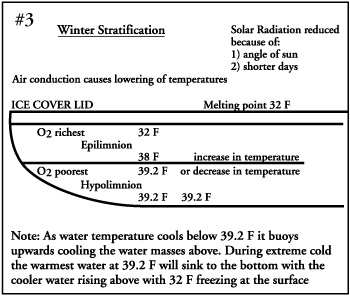
be on the surface and the warmest 39.2° F water to be on the lake’s bottom. (See Diagram 3) A lake’s ice lid cover in winter prohibits mixing by wind/wave action and locks in the stratification layers. Under the ice, oxygen production comes from photosynthesis caused by light penetration reaching the aquatic plants. A heavy snow and ice cover shields this needed light penetration and curtails oxygen production by plant photosynthesis.
During the winter the top hypolimnion water layer has the most oxygen, aquatic life, and fish. The middle thermocline layer is absent. The bottom hypolimnion layer is oxygen poor and devoid of life. Winter fish kill is caused by a complete blocking of sunlight penetration causing the aquatic plants to die. (See Diagram 4) The decaying of dead plants uses oxygen and depletes the lake’s oxygen causing fish death from suffocation. Aquatic animals further deplete oxygen by respiration.
During hot weather, fish are found close to the bottom layer of the epilimnion. They opt for the coolness of the thermocline but still require the oxygen richness of the epilimnion. Commonly, fish daily migrate to the shallows to feed and return to the comfort of the epilimnion-thermocline junction. Resting fish are most comfortable at this junction.
During the fall turnover, a lake blends these three layers into one uniform body of water with stable oxygen and temperatures throughout. This causes the fish to become highly active and very hungry. In the fall fish can become scattered due to these widespread ideal conditions.
Water temperatures initiate insect hatches. A cooler than normal year delays seasonal insect migrations. The calendar timing of an insect hatch can be altered by variations in local temperatures. For example, a cold front can delay the stonefly hatch on a river, spoiling a planned vacation. In addition, unseasonably warm temperatures may cause this same hatch to occur earlier than usual. Aquatic insects demand well-oxygenated water for emergence. Unseasonably warm temperatures may deplete the water’s oxygen content and retard insect emergence.
A stream’s current thoroughly blends its water, resulting in fairly uniform temperature and oxygen contents, but small

temperature variations may still happen. Since fish can detect a 0.1° F difference, they may seek out more favorable water temperatures during extreme warm weather conditions. At these times fish search out submerged springs and some cooler tributaries. For example, during extremely warm weather in Yellowstone Park, the Firehole River’s trout will school below the confluence of cooler tributary streams.
I believe that fish become activated by a sudden swing in temperature which brings the water to the fish’s ideal range. Especially after a prolonged spell of unfavorable warm or cold temperatures, this sudden change toward ideal temperatures highly activates the fish. This results in the fish going on a sudden active feeding spree. For example, a February Chinook-wind provokes a water temperature swing from stable thirties to the mid-forties° F. The fish answer by going on a feeding frenzy. The peculiarity of this event is that the forty degree temperatures are far below the trout’s preferred range of 55-60° F. The trout behave like college students from Minnesota on spring break in Texas. Likewise, if the dog days of summer are cooled by a sudden storm front causing a favorable cooler temperature swing, again the fish respond by actively feeding.
Two conditions resulting in extremely inactive fish are extreme cold (melting point) and heat (greater than 70° F for trout). During these times fish are so inactive it is as if they have disappeared. Perhaps they have migrated elsewhere.
During hot temperature times fly fishermen must monitor the water temperature to find the depth of the epilimnion/thermocline junction. (See Diagram 5) During high light conditions, target fish in the deepest portion of the epilimnion layer because the fish will concentrate there to rest. During low light conditions fish the upper layers of the epilimnion because fish migrate there to
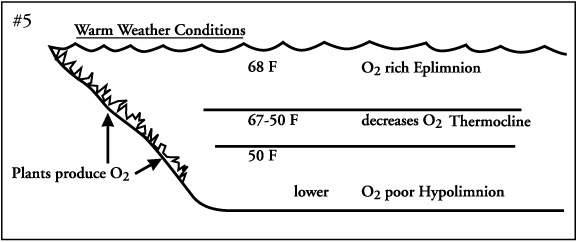
feed. In both cases locate areas where these depths coincide with bottom structures such as submerged weed beds.
In warm weather fish are most likely found at the junction of the epilimnion and the thermocline. The best area to locate fish is where this junction meets bottom structures such as submerged weed beds, shoals, and rocky bottoms. During these warm conditions fish will be concentrated in these areas during times of bright sunshine. At low light times they migrate to the shallows for feeding. Other fish species will behave similarly except their ideal temperature range will be different. For example, largemouth bass prefer 68-78° F and would be located just under the water surface. Look for protective cover structure just under the surface to find bass.
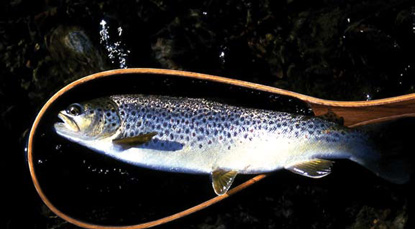

© 2025 The Gale Group, Inc. All rights reserved.
© 2025 Perigee Learning LLC. All rights reserved.
LoveTheOutdoors.com is owned and operated by Advameg, Inc. © 2025 Advameg, Inc.
Camping Adventures • Dutch Oven Cooking • Sports Knots
Fly Tying • Freshwater Fishing • Fly Fishing

